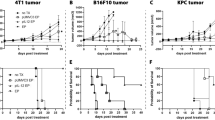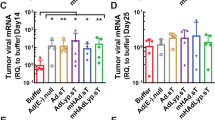Abstract
Gene-directed enzyme prodrug therapy (GDEPT) is a promising approach to local management of cancer through targeted chemotherapy. Killing localized tumors by GDEPT in a manner that induces strong antitumor cellular immune responses might improve local management and allow benefit in disseminated cancer. Here we evaluated the combination of nitroreductase (NTR)/CB1954 GDEPT with high-level expression of heat shock protein 70 (HSP70, a stress protein that can shuttle cytosolic peptides into antigen-presenting cells) for induction of antitumor immunity using adenovirus gene delivery in an aggressive and nonimmunogenic BALB/c syngeneic 4T1 breast cancer model. The mechanism of cell death and spectrum of stress proteins induced are likely to be important determinants of the resulting immune responses. We showed that NTR/CB1954 treatment of 4T1 cells gave both apoptotic and nonapoptotic killing. In vivo killing of 4T1 cells expressing NTR gave weak antitumor immunity and very limited induction of stress proteins including HSP70. High-level coexpression of HSP70 during NTR/CB1954-mediated killing of 4T1 cells in vivo gave much greater protection from tumor challenge (67% long-term survivors compared to 17%) and induced 4T1-specific cytotoxic T-cell responses. The enhancement of antitumor responses resulting from HSP70 coexpression was similar to that conferred by coexpression of GM-CSF.
This is a preview of subscription content, access via your institution
Access options
Subscribe to this journal
Receive 12 print issues and online access
$259.00 per year
only $21.58 per issue
Buy this article
- Purchase on Springer Link
- Instant access to full article PDF
Prices may be subject to local taxes which are calculated during checkout







Similar content being viewed by others
Abbreviations
- ATCC:
-
American Type Culture Collection
- bp:
-
base pairs
- CD40-L:
-
CD40 ligand
- IFN:
-
interferon
- IL:
-
interleukin
- MHC:
-
major histocompatibility complex
- nt:
-
nucleotides
- PER.C6:
-
human embryonic retina cells stably transformed with plasmid pIG.E1A.E1B clone 6
- SV40:
-
Simian virus 40
- TLR:
-
Toll-like receptor
References
Springer CJ, Niculescu-Duvaz I . Approaches to gene-directed enzyme prodrug therapy (GDEPT). Adv Exp Med Biol. 2000;465:403–409.
Nettelbeck DM, Jerome V, Muller R . Gene therapy: designer promoters for tumor targeting. Trends Genet. 2000;16:174–181.
Lipinski KS, Djeha AH, Ismail T, Mountain A, Young LS, Wrighton CJ . High-level, beta-catenin/TCF-dependent transgene expression in secondary colorectal cancer tissue. Mol Ther. 2001;4:365–371.
Rots MG, Curiel DT, Gerritsen WR, Haisma HJ . Targeted cancer gene therapy: the flexibility of adenoviral gene therapy vectors. J Control Rel. 2003;87:159–165.
van Beusechem VW, van Rijswijk Al, van ES HH, Haisma HJ, Pinedo HM, Gerritsen WR . Recombinant adenovirus vectors with knobless fibers for targeted gene transfer. Gene Therapy. 2000;7:1940–1946.
Knox RJ, Friedlos F, Jarman M, Roberts JJ . A new cytotoxic interstrand crosslinking agent, 5-(aziridin-1-yl)-4-hydroxylamino-2-nitrobenzamide, is formed from 5-(aziridin-1-yl)-2,4,-dinitrobenzamide (CB1954) by a nitroreductase enzyme in Walker carcinoma cells. Biochem Pharmacol. 1988;37:2661–2669.
Drabek D, Guy J, Craig R, Grosveld F . The expression of bacterial nitroreductase in transgenic mice results in specific cell killing by the prodrug CB1954. Gene Therapy. 1997;4:93–100.
Bridgewater JA, Knox RJ, Pitts JD, Collins MK, Springer CJ . The bystander effect of the nitroreductase/CB1954 enzyme/prodrug system is due to a cell-permeable metabolite. Hum Gene Ther. 1997;8:709–717.
Cui W, Gusterson B, Clark AJ . Nitroreductase-mediated cell ablation is very rapid and mediated by a p53-independent apoptotic pathway. Gene Therapy. 1999;6:764–770.
Djeha AH, Hulme A, Dexter MT, et al. Expression of Escherichia coli B nitroreductase in established human tumor xenografts in mice results in potent antitumoral and bystander effects upon systemic administration of the prodrug CB1954. Cancer Gene Ther. 2000;7:721–731.
Djeha AH, Thomson TA, Leung H, et al. Combined adenovirus-mediated nitroreductase gene delivery and CB1954 treatment: a well-tolerated therapy for established solid tumors. Mol Ther. 2001;3:233–240.
Palmer DH, Mautner V, Mirza D, et al. Virus-directed enzyme prodrug therapy: intratumoral administration of a replication-deficient adenovirus encoding nitroreductase to patients with resectable liver cancer. J Clin Oncol. 2004;22:1546–1552.
Haack K, Linnebacher M, Eisold S, Zoller M, von Knebel Doeberitz M, Gebert J . Induction of protective immunity against syngeneic rat cancer cells by expression of the cytosine deaminase suicide gene. Cancer Gene Ther. 2000;7:1357–1364.
Pavlovic J, Nawrath M, Tu R, Heinicke T, Moelling K . Anti-tumor immunity is involved in the thymidine kinase-mediated killing of tumors induced by activated Ki-ras(G12V). Gene Therapy. 1996;3:635–643.
Yamamoto S, Suzuki S, Hishino A, Akimoto M, Shimada T . Herpes simplex virus thymidine/ganciclovir-mediated killing of tumor cell induces tumor-specific cytotoxic T cells in mice. Cancer Gene Ther. 1997;4:91–96.
Tuting T, Storkus WJ, Lotze MT . Gene-based strategies for the immunotherapy of cancer. J Mol Med. 1997;75:478–491.
Ciavarra RP, Holtermann DA, Brown PR, et al. Prostate tumor microenvironment alters immune cells and prevents long-term survival in an orthotopic mouse model following flt3-ligand/CD40-ligand immunotherapy. J Immunother. 2004;27:13–26.
Kjaergaard J, Peng L, Cohen PA, Drazba JA, Weinberg AD, Shu S . Augmentation versus inhibition: effects of conjunctional OX-40 receptor monoclonal antibody and IL-2 treatment on adoptive immunotherapy of advanced tumor. J Immunol. 2001;167:6669–6677.
Arya M, Patel HR, Williamson M . Chemokines: key players in cancer. Curr Med Res Opin. 2003;19:557–564.
Houghton AN . LIGHTing the way for tumor immunity. Nat Immunol. 2004;5:123–124.
Gorelik L, Flavell RA . Immune-mediated eradication of tumors through the blockade of transforming-growth factor-beta signalling in T cells. Nat Med. 2001;7:1118–1122.
Dranoff G . GM-CSF-based cancer vaccines. Immunol Rev. 2002;188:147–154.
Buchsel PC, Forgey A, Grape FB, Hamann SS . Granulocyte macrophage colony-stimulating factor: current practise and novel approaches. Clin J Oncol Nurs. 2002;6:198–205.
Suto R, Srivastava PK . A mechanism for the specific immunogenicity of heat shock protein-chaperoned peptides. Science. 1995;269:1585–1588.
Castelli C, Rivoltini L, Rini F, et al. Heat shock proteins: biological functions and clinical applications as personalized vaccines for human cancer. Cancer Immunol Immunother. 2004;53:227–233.
Todryk SM, Gough MJ, Pockley AG . Facets of heat shock protein 70 show immunotherapeutic potential. Immunology. 2003;110:1–9.
Basu S, Binder RJ, Ramalingam T, Srivastava PK . CD91 is a common receptor for heat shock proteins gp96, HSP90, HSP70, and calreticulin. Immunity. 2001;14:303–313.
Becker T, Hartl FU, Wieland F . CD40, an extracellular receptor for binding and uptake of Hsp70–peptide complexes. J Cell Biol. 2002;158:1277–1285.
Delneste Y, Magistrelli G, Gauchat J, et al. Involvement of LOX-1 in dendritic cell-mediated antigen cross-presentation. Immunity. 2002;17:353–362.
Srivastava P . Roles of heat-shock proteins in innate and adaptive immunity. Nat Rev Immunol. 2002;2:185–194.
Asea A, Kraeft SK, Kurt-Jones EA, et al. HSP70 stimulates cytokine production through a CD14-dependant pathway, demonstrating its dual role as a chaperone and cytokine. Nat Med. 2000;6:435–442.
Asea A, Rehli M, Kabingu E, et al. Novel signal transduction pathway utilized by extracellular HSP70: role of toll-like receptor (TLR) 2 and TLR4. J Biol Chem. 2002;277:15028–15034.
Basu S, Binder RJ, Suto R, Anderson KM, Srivastava PK . Necrotic but not apoptotic cell death releases heat shock proteins, which deliver a partial maturation signal to dendritic cells and activate the NF-kappa B pathway. Int Immunol. 2000;12:1539–1546.
Melcher A, Todryk S, Hardwick N, Ford M, Jacobson M, Vile RG . Tumor immunogenicity is determined by the mechanism of cell death via induction of heat shock protein expression. Nat Med. 1998;4:581–587.
Gough MJ, Melcher AA, Ahmed A, et al. Macrophages orchestrate the immune response to tumor cell death. Cancer Res. 2001;61:7240–7247.
Gallucci S, Lolkema M, Matzinger P . Natural adjuvants: endogenous activators of dendritic cells. Nat Med. 1999;5:1249–1255.
Green NK, McNeish IA, Doshi R, Searle PF, Kerr DJ, Young LS . Immune enhancement of nitroreductase-induced cytotoxicity: studies using a bicistronic adenovirus vector. Int J Cancer. 2003;104:104–112.
Lipinski KS, Djeha AH, Krausz E, et al. Tumor-specific therapeutic adenovirus vectors: repression of transgene expression in healthy cells by endogenous p53. Gene Therapy. 2001;8:274–281.
Dexter DL, Kowalski HM, Blazar BA, Fligiel Z, Vogel R, Heppner GH . Heterogeneity of tumor cells from a single mouse mammary tumor. Cancer Res. 1978;38:3174–3181.
Shih C, Padhy LC, Murray M, Weinberg RA . Transforming genes of carcinomas and neuroblastomas introduced into mouse fibroblasts. Nature. 1981;290:261–264.
Irvine AS, Trinder PK, Laughton DL, et al. Efficient nonviral transfection of dendritic cells and their use for in vivo immunization. Nat Biotech. 2000;18:1273–1278.
Benedetti S, Dimeco F, Pollo B, et al. Limited efficacy of the HSV-TK/GCV system for gene therapy of malignant gliomas and perspectives for the combined transduction of the interleukin-4 gene. Hum Gene Ther. 1997;8:1345–1353.
Santodonato L, D'Agostino G, Santini SM, et al. Local and systemic antitumor response after combined therapy of mouse metastatic tumors with tumor cells expressing IFN-alpha and HSVtk: perspectives for the generation of cancer vaccines. Gene Therapy. 1997;4:1246–1255.
Felzmann T, Ramsey WJ, Blaese RM . Characterization of antitumor immune response generated by treatment of murine tumors with recombinant adenoviruses expressing HSVtk, IL-2, IL-6 or B7-1. Gene Therapy. 1997;4:1322–1329.
Jones RK, Pope IM, Kinsella AR, Watson AJ, Christmas SE . Combined suicide and granulocyte–macrophage colony-stimulating factor gene therapy induces complete tumor regression and generates antitumor immunity. Cancer Gene Ther. 2000;7:1519–1528.
Toda M, Martuza RL, Rabkin SD . Combination suicide/cytokine gene therapy as adjuvants to a defective herpes simplex virus-based cancer vaccine. Gene Ther. 2001;8:332–339.
Sakai Y, Kaneko S, Nakamoto Y, Kagaya T, Mukaida N, Kobayashi K . Enhanced anti-tumor effects of herpes simplex virus thymidine kinase/ganciclovir system by codelivering monocyte chemoattractant protein-1 in hepatocellular carcinoma. Cancer Gene Ther. 2001;8:695–704.
Park KM, Kim G, Jang SH, et al. Gene therapy with GM-CSF, interleukin-4 and herpes simplex virus thymidine kinase shows strong antitumor effect on lung cancer. Anticancer Res. 2003;23:1559–1564.
Cao X, Ju DW, Tao Q, et al. Adenovirus-mediated GM-CSF gene and cytosine deaminase gene transfer followed by 5-fluorocytosine administration elicit more potent antitumor response in tumor-bearing mice. Gene Therapy. 1998;5:1130–1136.
Ju DW, Cao X, Tao Q, Wang B, Chen G, Yu Y . Augmentation of antitumor effect of adenovirus-mediated CD suicide gene therapy by cotransfer of interleukin 2 gene in melanoma-bearing mice. Chin Med J (Engl). 1999;112:162–165.
Ju DW, Yang Y, Tao Q, et al. Interleukin-18 gene transfer increases antitumor effects of suicide gene therapy through efficient induction of antitumor immunity. Gene Therapy. 2000;7:1672–1679.
Pulaski BA, Ostrand-Rosenberg S . Reduction of established spontaneous mammary carcinoma metastases following immunotherapy with major histocompatibility complex II and B7.1 cell-based vaccines. Cancer Res. 1998;58:1486–1493.
Wu RS, Kobie JJ, Besselsen DG, et al. Comparative analysis of IFN-gamma B7.1 and antisense TGF-beta gene transfer on the tumorigenicity of a poorly immunogenic metastatic mammary carcinoma. Cancer Immunol Immunother. 2001;50:229–240.
Lukacs KV, Nakakes A, Atkins CJ, Lowrie DB, Colston MJ . In vivo gene therapy of malignant tumors with heat shock protein-65 gene. Gene Therapy. 1997;4:346–350.
Rafiee M, Kanwar JR, Berg RW, Lehnert K, Lisowska K, Krissansen GW . Induction of systemic antitumor immunity by gene transfer of mammalian heat shock protein 70.1 into tumors in situ. Cancer Gene Ther. 2001;8:974–981.
Massa C, Guiducci C, Arioli I, Parenza M, Colombo MP, Melani C . Enhanced efficacy of tumor cell vaccines transfected with secretable hsp70. Cancer Res. 2004;64:1502–1508.
Palmer DH, Milner AE, Kerr DJ, Young LS . Mechanism of cell death induced by the novel enzyme-prodrug combination, nitroreductase/CB1954, and identification of synergism with 5-fluorouracil. Br J Cancer. 2003;89:944–950.
Scott P . IFN-Gamma modulates the early development of Th1 and Th2 responses in a murine model of cutaneous leishmaniasis. J Immunol. 1991;147:3149–3155.
Acknowledgements
S Todryk acknowledges Science Foundation Ireland for support. We thank R Vile for supplying an HSP70 expression plasmid.
Author information
Authors and Affiliations
Corresponding author
Rights and permissions
About this article
Cite this article
Djeha, H., Todryk, S., Pelech, S. et al. Antitumor immune responses mediated by adenoviral GDEPT using nitroreductase/CB1954 is enhanced by high-level coexpression of heat shock protein 70. Cancer Gene Ther 12, 560–571 (2005). https://doi.org/10.1038/sj.cgt.7700807
Received:
Published:
Issue Date:
DOI: https://doi.org/10.1038/sj.cgt.7700807
Keywords
This article is cited by
-
Combining gene and immunotherapy for prostate cancer
Prostate Cancer and Prostatic Diseases (2008)
-
Nitroreductase-based therapy of prostate cancer, enhanced by raising expression of heat shock protein 70, acts through increased anti-tumour immunity
Cancer Immunology, Immunotherapy (2006)



